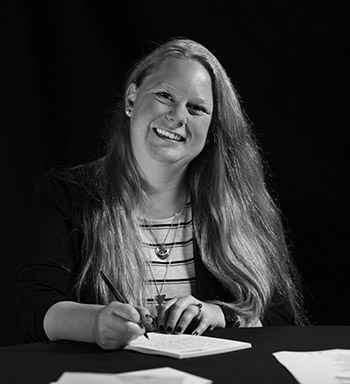By Brandon Hartman

When Northrop Grumman Electrical Power Subsystems Lead Meg was tagged in a social media post on her mom’s Facebook profile in the fall of 2020 — proudly highlighting Meg’s work in mission control for a Cygnus launch — she had no idea she would become famous in her hometown of Edmond, Oklahoma.
In Edmond, the running joke is that everyone knows everyone, and STEM careers — specifically, careers in space exploration — are often viewed as inaccessible. So, when her mom’s friends and neighbors learned that Meg helped deliver crew supplies, equipment and scientific experiments to the International Space Station, there was a lot of interest.
At first, one parent reached out to see if Meg would provide career advice to their 12-year-old son through social media. After Meg began her correspondence with him, word got out. Soon, she was responding to both physical and emailed letters from many young Oklahomans looking to follow in her footsteps.
“The kids back home see portrayals of STEM professionals in the media, but they don’t usually know any real scientists or engineers working with the space program and, by extension, don’t often see themselves in those kinds of roles,” said Meg. “All of a sudden, I was becoming a mentor and role model to these kids, and it was something I quickly came to value. I wanted to help make a difference.”
Finding Her Way
From a young age, engineering intrigued Meg. She would perform experiments around her house such as pulling apart and then wiring together old calculators to see if they could communicate.
This childhood interest was reignited while working in a bio-sensors lab as an undergraduate at Oklahoma State University and, later, on a study abroad trip to China, while designing nano sensors that could detect bacteria in liquid food products. Meg graduated with a degree in Biosystems and Agricultural Engineering, then spent four years engineering control systems for agricultural spray aircraft.
“ATK offered me a job designing automation upgrades for ammunition packing lines at the Lake City Army Ammunitions Plant in Kansas City, and a few weeks later, the company merged with Northrop Grumman. My top two companies became one.”
— Meg
While she enjoyed agricultural engineering, Meg was ready for a new workplace culture and made a list of her five dream employers.
“At the top of my list was Northrop Grumman and [heritage company] Orbital ATK,” said Meg. “Orbital ATK offered me a job designing automation upgrades for ammunition packing lines at the Lake City Army Ammunitions Plant in Kansas City, and a few weeks later, the company merged with Northrop Grumman. My top two companies became one.”
In 2020, Meg had the opportunity to move halfway across the country to Dulles, Virginia, and work on spacecraft including Cygnus and the Mission Extension Vehicle, which helps extend the life of in-orbit satellites.
“I had never lived outside of the Midwest and was nervous about moving during a pandemic, but I quickly fell in love with working on spacecraft,” said Meg. “It was clear I was at a place where I knew I belonged.”
Life Lessons and Letters
The recipient of Meg’s first letter back in 2020 happened to be a student on the autism spectrum; part of why his mother had asked if Meg would share her experience working in the space industry was because a recognized feature of autism is hyper-focusing on a skill or a specific area of interest, and space was her son’s particular passion. As a result, many of the parents who reached out following that first interaction ended up also being parents of neurodiverse children.
“Often times, neurodiverse kids do not see career paths available to them in their areas of interest, but already have critical skills in math and programming,” said Meg. “Many of these kids have a love and knowledge of all things space that would make them excellent STEM team members.”
Today, facilitated by parents, Meg regularly corresponds with five students all between the ages of 11 and 14, and communicates ad-hoc with numerous parents and students over social media. Often sending career advice, information about the space program at Northrop Grumman and, occasionally, posters, the goal is to inspire and help students understand that they can one day contribute to what they see in the skies above.
“To get to where we as a country are going — exploring Mars and beyond — we are going to need everyone on that journey,” said Meg. “Every scientist and STEM professional has key experiences in their development that help them on the road to their career. There is so much value to mentoring and providing opportunities to others, and I hope everyone has the chance to work with students in their communities.”

Life at Northrop Grumman: Recent Stories
Shape your career journey with diverse roles and experiences that expand your expertise, feed your curiosity, and fuel your passion.

Life at Northrop Grumman: Archived Stories
It takes every one of us to make the impossible a reality. See what life is like at Northrop Grumman.